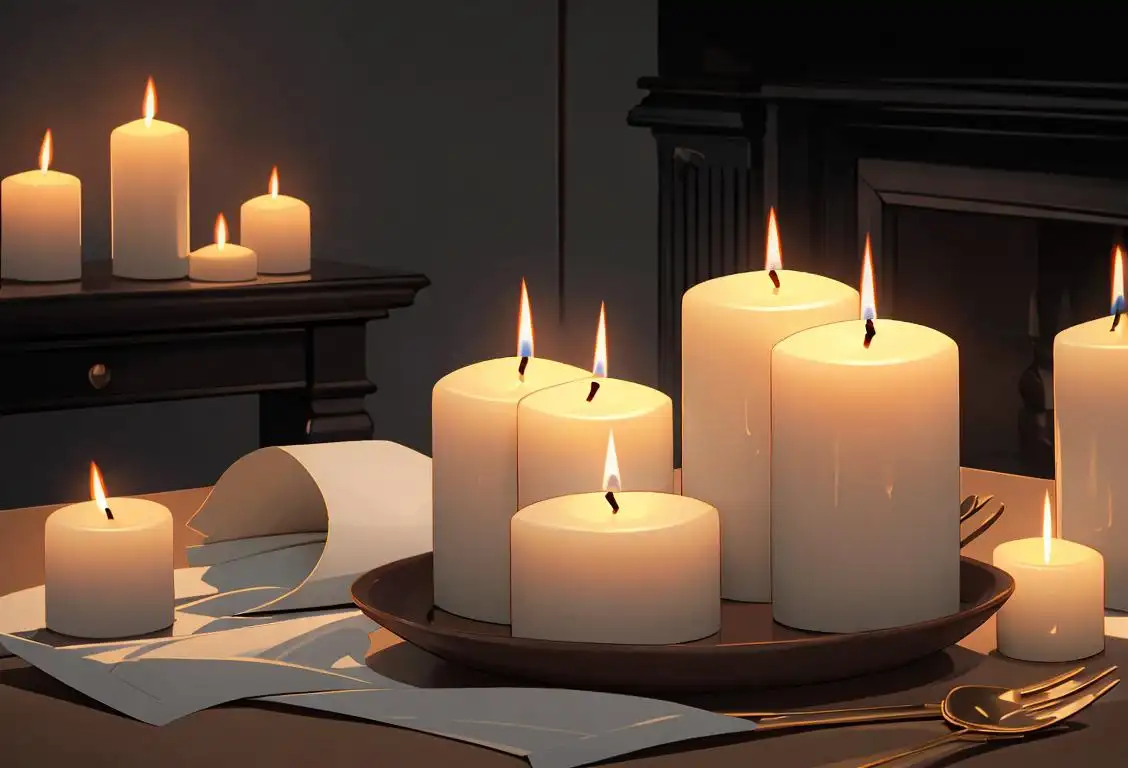National Candle Day

Welcome to the wonderful world of National Candle Day, where we celebrate the flickering flames that bring warmth, coziness, and a touch of magic to our lives. Light up your imagination as we delve into the fascinating history and significance behind this illuminating holiday.
When is Candle Day?
It's national candle day on the 5th December.
The Glow of National Candle Day
Imagine a world without candles – no romantic candlelit dinners, no soothing aromatherapy scents, and no power outages saved by the trusty flicker of a single flame. It's hard to picture, right? Thankfully, National Candle Day reminds us of the incredible invention that has been a beacon of light for centuries.
Historians believe that candles have been used by humanity for over 5,000 years. The ancient Egyptians were among the first to develop wicked candles made from reeds soaked in animal fat. Over time, civilizations around the world discovered various materials to form the waxy substance that burns cleanly. From beeswax to tallow, paraffin to soy, candles have evolved into a beloved symbol of warmth, celebration, and relaxation.
A Bright and Illuminating Celebration
On National Candle Day, we encourage you to embrace the soothing ambiance of candlelight. Don't be afraid to let your inner pyromaniac loose (safely, of course).
Here are a few ways to celebrate this luminous holiday:
- Create a cozy atmosphere at home by lighting aromatic candles that fill the air with delightful scents.
- Host a candlelit dinner for your loved ones and bask in the romantic glow.
- Try your hand at making your own candles. Get artistic and experiment with different colors, shapes, and fragrances.
- Take a relaxing bubble bath and let the calming flicker of a candle melt away your stress.
- Remember those who came before us by incorporating candles into a remembrance ceremony.
Did You Know?
Did you know that candles were once used as a form of currency? In ancient Rome, candles made from tallow were considered valuable enough to be used as a form of exchange. Imagine trading your candles for goods and services. It's like having a pocketful of illumination!
History behind the term 'Candle'
3000 BCE
Early Candle-like Objects
In ancient Egypt, around 3000 BCE, the first recorded evidence of candle-like objects called rushlights emerged. These rushlights were made by soaking the pithy core of the reed in animal fat or other natural oils. When lit, they provided a small but useful source of light.
3000 BC
The Ancient Origins
Candles have a long and fascinating history that dates back to ancient times. The earliest evidence of candle-like objects can be traced back to around 3000 BC in ancient Egypt. These early candles were made from rushes or reeds coated with animal fat. The materials were readily available and easy to shape, making them a practical source of light.
3000 BC
The discovery of fire
Fire was first discovered by early humans, marking a significant milestone in their development. They learned to harness the power of fire for various purposes, including creating light in darkness.
200 BC
The Evolution of Candle Making
As candle making techniques evolved, so did the materials used. In around 200 BC, the Chinese began using beeswax to create candles. Beeswax provided a cleaner and less odorous alternative to animal fat, resulting in candles that burned with a brighter and more pleasant light. The use of beeswax candles soon spread to other regions of the world.
200 BCE
The Emergence of Tallow Candles
Around 200 BCE, tallow candles made from animal fats, such as beef or mutton tallow, began to be used. Tallow candles were solid and had a wick made of twisted fibers, providing a more efficient and longer-lasting source of light compared to rushlights. They were widely used in ancient Rome and Greece.
2000 BC
Ancient Mesopotamian lamps
The ancient Mesopotamians, particularly in what is now modern-day Iraq, used clay lamps filled with oil or fat as a source of light. They would insert a woven reed as a wick to provide a steady and long-lasting flame.
400 CE
Introduction of Beeswax Candles
In the 4th century CE, beeswax candles were introduced by the Romans. Beeswax, harvested from beehives, produced candles that had a pleasant smell when burned and gave off a brighter, cleaner light. Due to their higher cost, beeswax candles were primarily used for religious and ceremonial purposes.
200 AD
Romans introduce the rushlight
The Romans introduced the rushlight, made by soaking the pithy core of the rush plant in animal fat. These inexpensive and readily available materials provided a simple yet effective source of light.
13th Century
Introduction of Tallow Candles
During the 13th century, tallow candles became popular in Europe. Tallow, a rendered form of animal fat, was abundant and inexpensive, making it a widely used material for candle making. However, tallow candles produced a significant amount of smoke and had an unpleasant odor when burned.
1292
Tallow candles in England
In England, tallow candles made from animal fat (usually beef or mutton) became commonly used. These candles emitted a pungent odor and gave off a dim, flickering light.
13th Century
The Candlemaking Guilds
During the 13th century, candlemaking guilds started to appear in Europe. These guilds consisted of skilled artisans who specialized in candle production. They established quality standards and techniques to ensure consistent and reliable candles, making the trade of candlemaking an esteemed craft.
15th Century
Emergence of Beeswax Candles
In the 15th century, beeswax candles regained popularity in Europe. They were particularly favored by the church due to their clean-burning qualities and sweet fragrance. Beeswax candles were often used in religious ceremonies and played a significant role in decorative candlemaking.
18th Century
The Advent of Stearine Candles
In the 18th century, a new type of candle made from stearic acid was introduced. Stearine candles burned brighter and had a longer burning time compared to tallow candles. Stearine, derived from animal or vegetable fats, offered an improved alternative to tallow but was still lacking in cleanliness and scent.
1400s
Beeswax candles gain popularity
Beeswax candles, known for their pleasant aroma and cleaner burn, gained popularity among the wealthy. However, due to the high cost of beeswax, they were predominantly used in churches and by the nobility.
17th Century
Introduction of Tallow Dips
In the 17th century, tallow dips became popular and widely used. These candles were made by repeatedly dipping a wick into melted tallow until the desired thickness was achieved. Tallow dips were cheaper to produce and were commonly used by the general population for everyday lighting.
1834
Discovery of Stearic Acid
In 1834, French chemist Michel Eugène Chevreul discovered stearic acid, a fatty acid derived from animal fats or vegetable oils. Stearic acid played a crucial role in candlemaking as it helped candles burn longer and more evenly.
1834
Paraffin candles revolutionize lighting
The invention of paraffin wax by chemist Carl Reichenbach revolutionized candle-making. Paraffin, derived from petroleum, produced a brighter and more consistent flame, making candles more accessible to the masses.
19th Century
The Birth of Paraffin Wax Candles
The 19th century marked a significant advancement in candle making with the discovery and commercial production of paraffin wax. Paraffin wax, derived from petroleum, revolutionized the candle industry. It burned cleanly, was odorless, and could be easily molded into various shapes. Paraffin wax candles quickly gained popularity and became the standard candles used for everyday lighting.
20th Century
Introduction of Soy and Beeswax Blends
In the 20th century, as awareness of environmental concerns grew, alternative candle materials gained traction. Soy candles, made from soybean oil, gained popularity due to their renewable and biodegradable nature. Additionally, beeswax candles continued to be highly regarded for their natural qualities.
1879
Introduction of Paraffin Wax Candles
The introduction of paraffin wax candles in 1879 marked a significant milestone in candle production. Paraffin wax, a byproduct of petroleum refining, provided an affordable and odorless alternative to tallow and beeswax. This advancement made candles accessible to the masses, leading to widespread use in households.
1850s
Introduction of kerosene lamps
The discovery of petroleum and the subsequent development of kerosene lamps contributed to the decline in candle usage. These lamps provided a more efficient and reliable source of light, especially for indoor illumination.
21st Century
Advent of Decorative and Scented Candles
In the 21st century, candles have become more than just a source of light. Decorative and scented candles have taken the market by storm. With an endless array of designs, shapes, and fragrances, candles have become a popular choice for creating ambiance, relaxation, and enhancing interior decor.
1879
Thomas Edison's electric light
Thomas Edison's successful development of the practical incandescent light bulb marked a huge leap forward in lighting technology. The widespread adoption of electric light bulbs eventually led to a decline in the use of traditional candles.
20th Century
Transition to Modern Candle Materials
Throughout the 20th century, candle production saw a shift towards modern materials such as soy wax, palm wax, and other vegetable-based waxes. These alternatives to traditional animal-based waxes appealed to those seeking eco-friendly options, as they are renewable and biodegradable.
Present
Symbolism and specialty candles
In modern times, candles have become more than just a practical source of light. They are often used in religious and ceremonial settings, as well as for relaxation and ambiance. Additionally, specialty candles with unique designs and scents have gained popularity as decorative items.
Did you know?
Did you know that candles were once used as a form of currency in ancient Rome?Tagged
romance loved ones rememberance relaxationFirst identified
1st December 2017Most mentioned on
5th December 2020Total mentions
420Other days
Candle Day
Family Day
Do Something Nice Day
Action Day
Boyf Day
Spouses Day
Seniors Day
Opposite Day
Happiness Day
One Day








